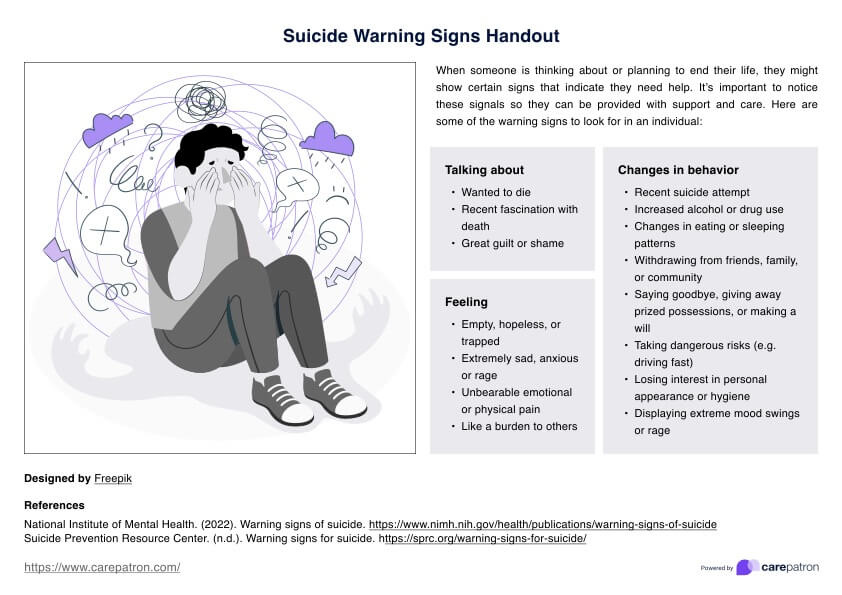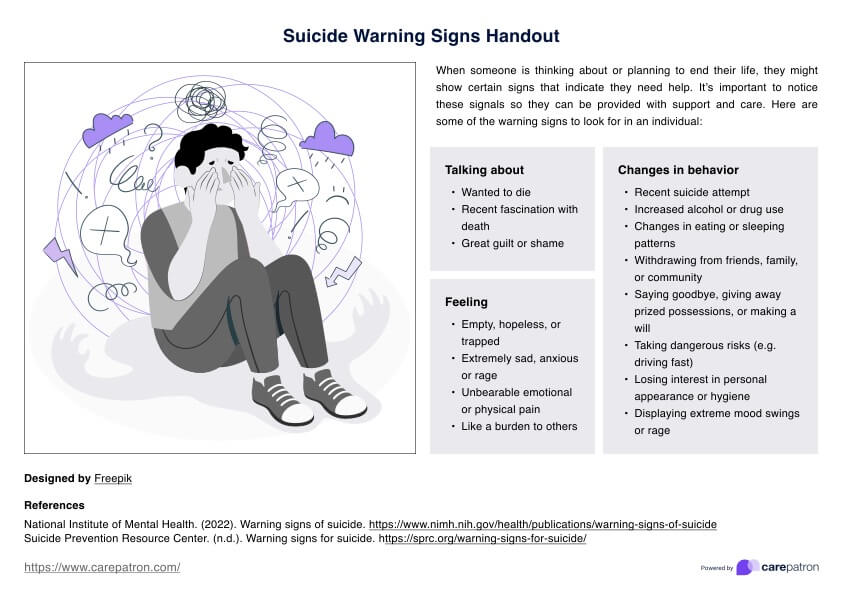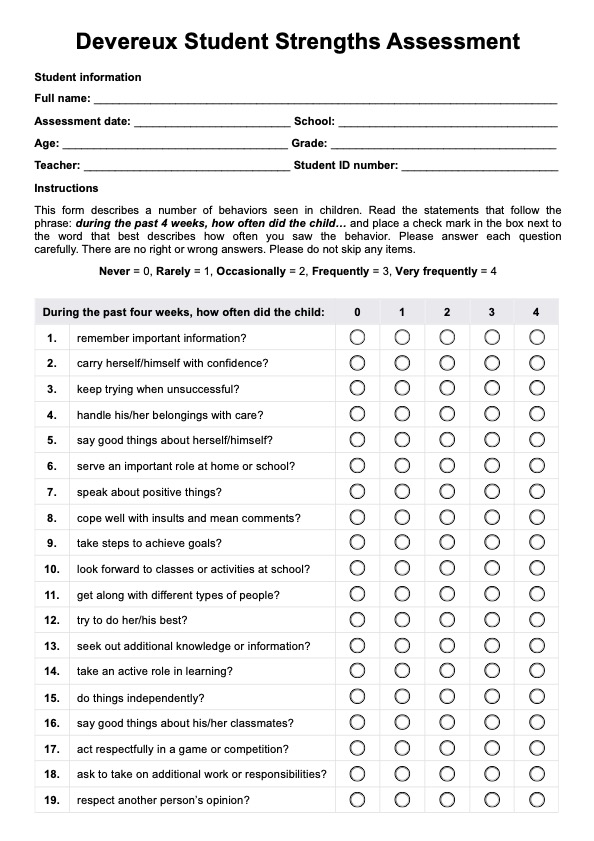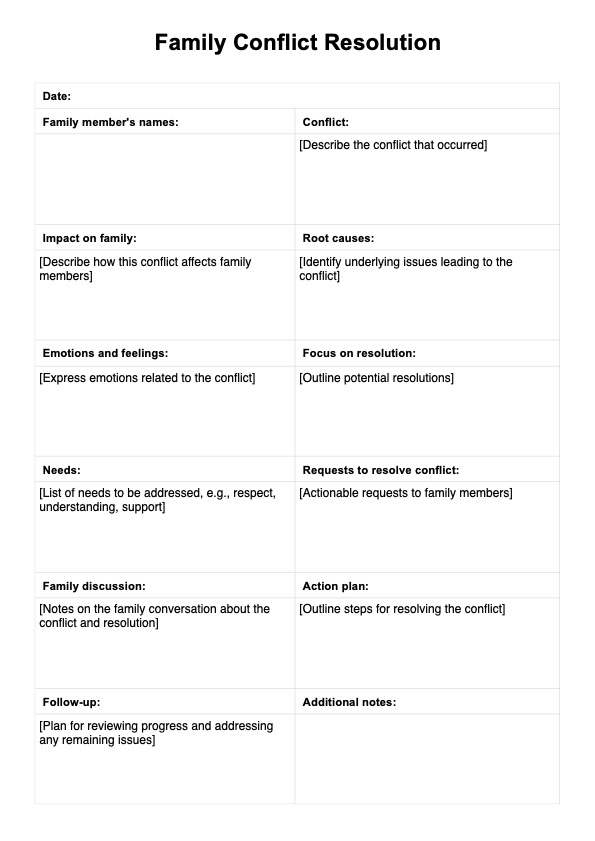Suicide Warning Signs Handout
Recognize common warning signs of suicidal behavior with a Suicide Warning Signs Handout. Learn the risk factors to provide timely support and prevent suicide.


Importance of familiarity with suicide warning signs
Being familiar with suicide warning signs helps recognize when someone might be at risk of attempting suicide. Understanding these signs, especially if there is a family history of suicide, can enable timely intervention and support. This knowledge can make a life-saving difference in preventing a tragedy.
Around 703,000 people die by suicide annually, with many more attempting it. Suicide affects people of all ages and was the fourth leading cause of death among 15–29-year-olds worldwide in 2019. Common methods include pesticide poisoning, hanging, and firearms, with a significant number of cases in rural areas of low- and middle-income countries (World Health Organization, 2023).
Suicide Warning Signs Handout Template
Suicide Warning Signs Handout Example
Common suicide warning signs
When someone is thinking about or planning to end their life, they might show certain signs that indicate they need help. It's important to notice these signals so they can be provided with support and care. Here are some of the warning signs to look for in an individual (National Institute of Mental Health, 2022; Suicide Prevention Resource Center, n.d.):
Things the individual might talk about
- Wanting to die
- A recent fascination with death
- Great guilt or shame
Things the individual might be feeling
- Empty, hopeless, or trapped
- Extremely sad, anxious
- Unbearable emotional or physical pain
- Like a burden to others
Changes in the individual's behavior
- Recent suicide attempt
- Shows impulsive behavior and taking dangerous risks (e.g., driving fast)
- Losing interest in personal appearance or hygiene
- Displaying extreme mood swings or rage
- Increased alcohol or drug use
- Changes in eating or sleeping patterns
- Withdrawing from friends, family, or community
- Saying goodbye, giving away prized possessions, or making a will
Knowing these signs is a vital component of mental health care. If someone has attempted suicide recently, constant monitoring and follow-up are necessary.
How to use our Suicide Warning Signs Handout template
People with suicidal tendencies sometimes do not seek help, and it can be challenging for therapists and their caregivers. Our Suicide Warning Signs Handout template is a practical resource to have to recognize and respond to signs of suicidal behavior in clients. Follow these simple steps to use the handout effectively.
Step 1: Download the template
Download the Suicide Warning Signs Handout template to your computer or device. Make sure it's easily accessible for future reference.
Step 2: Review the warning signs
Carefully read through the handout to familiarize yourself with the common warning signs of suicidal behavior. Understanding these signs can help you identify when someone might be in crisis.
Step 3: Share with others
Distribute the handout to those who may benefit, especially the client's family. This information can be crucial in encouraging people to seek mental health treatment, substance abuse treatment, or contact a suicide and crisis lifeline.
Step 4: Keep it accessible
Keep the handout in a visible and easily accessible place. This ensures it's readily available when you need to reference the warning signs or provide immediate support to someone in need.
How this handout may benefit a mental health professional
Having this Suicide Warning Signs Handout can:
Enhance early detection
Spot warning signs of suicidal behavior in your clients sooner. Early detection means you can intervene before things escalate.
Support client education
Share this handout with clients or their families, guiding them on what to look for. It will help them understand the risks and when to seek help.
Facilitate crisis planning
The handout is a handy tool for creating effective client safety plans. It helps guide conversations around managing crises and connecting to support services like a suicide and crisis lifeline in case of immediate danger.
Interventions to prevent suicide
While suicide is definitely cause for concern, it can be prevented. WHO recommends the following measures that should be taken:
- Restrict access to suicide methods: Limiting access to tools like pesticides, firearms, and certain medications can reduce the risk of suicide attempts.
- Work with the media for responsible suicide reporting: Encouraging the media to report on suicide responsibly can help prevent copycat incidents and reduce stigma.
- Develop socio-emotional skills in adolescents: Teaching adolescents socio-emotional skills equips them to handle stress and emotional challenges more effectively.
- Identify, assess, manage, and follow up with those affected by suicidal behavior: Early identification and ongoing support for individuals at risk and in emotional distress can prevent suicide and promote recovery.
Additionally, remember that someone who is suicidal needs compassion, understanding, and immediate support. They need to know they are not alone and that help is available. A listening ear can make a life-saving difference.
References
National Institute of Mental Health. (2022). Warning signs of suicide. https://www.nimh.nih.gov/health/publications/warning-signs-of-suicide
Suicide Prevention Resource Center. (n.d.). Warning signs for suicide. https://sprc.org/warning-signs-for-suicide/
World Health Organization. (2023, August 28). Suicide. https://www.who.int/news-room/fact-sheets/detail/suicide
Commonly asked questions
A risk factor for suicide is a condition or event that increases the likelihood of someone attempting or dying by suicide, such as mental health conditions like depression or a history of trauma.
Suicidal ideations are thoughts about wanting to end one's life or planning how to do so.
According to the World Health Organization, suicide rates are elevated among vulnerable groups facing discrimination, including refugees and migrants, indigenous peoples, LGBTI individuals, and prisoners.
If someone is planning to attempt suicide, you should immediately seek professional help, stay with them to ensure their safety, and contact emergency services or a crisis hotline.




















-template.jpg)



















































































